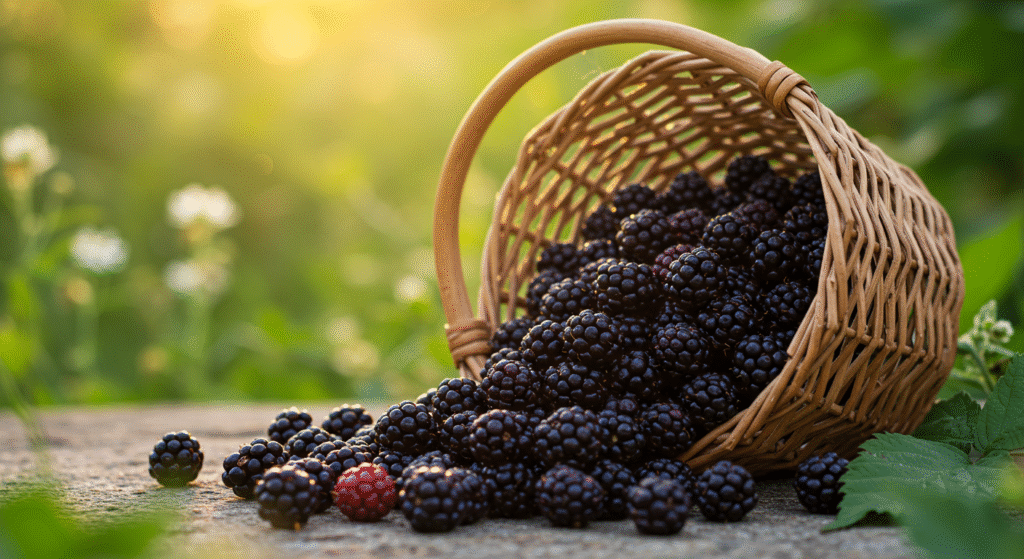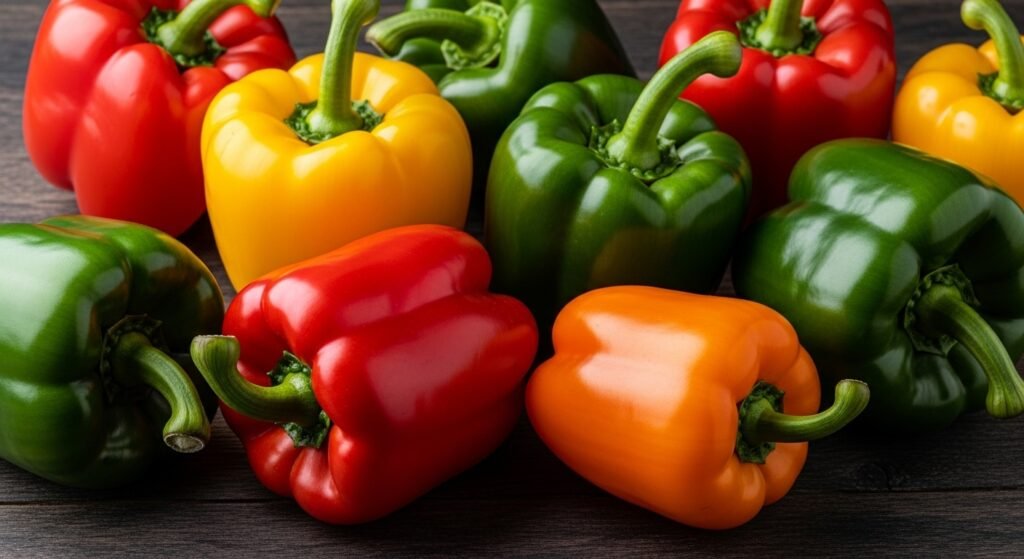Jul 11, 2025
40 Nutritious Foods That Start with B for a Balanced Diet
Introduction
In the quest for a healthier lifestyle, what we choose to put on our plate plays a pivotal role. Nutrient-dense foods provide the foundation for energy, growth, immunity, and overall well-being. While many of us are aware of the benefits of fruits, vegetables, whole grains, and lean proteins, categorizing food alphabetically can offer a refreshing and engaging approach to nutrition education.
This article explores 40 nutritious foods that begin with the letter “B.” From common staples like bananas and broccoli to lesser-known treasures such as black salsify and buckwheat, each entry is selected for its unique health benefits and contribution to a balanced diet. By broadening your food vocabulary and embracing variety, you’ll not only enrich your meals but also fuel your body with the diverse nutrients it craves.
Let’s discover how these “B” foods can add flavor, texture, and vitality to your daily plate.
Bananas
Bananas are one of the most widely consumed fruits worldwide, known for their natural sweetness and creamy texture. Rich in potassium, they support heart health and help maintain healthy blood pressure levels. Bananas also provide quick energy, making them ideal for pre-workout snacks, and contain vitamin B6 for brain function and mood regulation.

Broccoli
A cruciferous vegetable powerhouse, broccoli is loaded with vitamins C, K, and A, as well as fiber and antioxidants. Its anti-inflammatory properties make it excellent for supporting immune function and reducing the risk of chronic diseases. Steamed, roasted, or raw, broccoli adds both crunch and nutrition to your meals.
Blueberries
Small but mighty, blueberries are brimming with antioxidants—especially anthocyanins—that help fight free radicals and support brain health. They are also high in vitamin C, fiber, and manganese, promoting skin health, digestion, and metabolic function. Blueberries make a great addition to smoothies, cereals, and salads.
Black Beans
A staple in many global cuisines, black beans are an excellent plant-based protein source. Packed with fiber, folate, iron, and magnesium, they help stabilize blood sugar, promote heart health, and support muscle recovery. Their earthy flavor complements soups, stews, rice dishes, and salads.
Brussels Sprouts
Often underrated, Brussels sprouts are dense in nutrients like vitamin K, vitamin C, folate, and antioxidants. They support bone health, detoxification, and reduce inflammation. Roasting them brings out a nutty flavor that even skeptics may learn to enjoy.
Barley
Barley is an ancient whole grain rich in soluble fiber, particularly beta-glucan, which helps lower cholesterol and improve heart health. It also supports digestion and offers a steady release of energy due to its complex carbohydrates. Barley can be used in soups, stews, grain bowls, or as a substitute for rice.
Beets
Vibrant in color and flavor, beets are packed with nitrates, which improve blood flow and stamina. They are a good source of folate, manganese, and antioxidants, supporting liver function and reducing inflammation. Whether roasted, juiced, or grated raw into salads, beets offer a unique earthy sweetness.
Blackberries
These dark purple berries are nutritional gems filled with vitamin C, vitamin K, and fiber. They’re known for their anti-inflammatory and antioxidant properties, which protect the brain and promote glowing skin. Their tart-sweet flavor pairs beautifully with yogurt, oatmeal, or as a fresh snack on their own.

Brazil Nuts
Brazil nuts are among the richest sources of selenium—a trace mineral critical for thyroid health and antioxidant function. Just one or two nuts a day can meet your daily selenium needs. They also offer healthy fats, magnesium, and zinc, making them a heart-healthy snack in moderation.
Bok Choy
Also known as Chinese cabbage, bok choy is a leafy green full of vitamins A, C, and K, as well as calcium and potassium. It’s low in calories but high in nutritional value, supporting bone strength and immune health. Often used in stir-fries and soups, it has a mild, slightly peppery taste.
Black Rice
Sometimes called “forbidden rice,” black rice is rich in anthocyanins—the same powerful antioxidants found in blueberries. It also contains more protein and fiber than white rice, making it a superior choice for sustained energy and blood sugar control. With its deep color and nutty flavor, black rice is a striking and nutritious base for bowls and side dishes.
Butternut Squash
This vibrant orange squash is a rich source of beta-carotene, which the body converts into vitamin A for eye and immune health. It’s also high in fiber and potassium, supporting heart and digestive health. Its naturally sweet flavor makes it perfect for roasting, soups, and even purees for baking.
Butter Beans
Also known as lima beans, butter beans are creamy legumes high in plant-based protein, fiber, and essential minerals like iron and magnesium. They help regulate blood sugar and support muscle function. Their mild flavor absorbs herbs and spices well, making them ideal in stews and vegetarian dishes.
Black-Eyed Peas
A traditional food in many cultures, black-eyed peas are a great source of folate, fiber, and iron. They support red blood cell production, digestion, and heart health. Whether simmered in soups or served with grains, they’re a nourishing and versatile legume.
Basil
More than just a garnish, basil is a fragrant herb packed with vitamin K, antioxidants, and natural anti-inflammatory compounds. It supports cardiovascular health and adds freshness to any dish. From pesto to salads, basil’s sweet and peppery notes elevate a wide range of meals.
Brown Rice
Brown rice is a whole grain that retains its bran and germ layers, making it higher in fiber, vitamins, and minerals than white rice. It provides slow-digesting carbohydrates for steady energy and supports heart and digestive health. Brown rice is a staple that pairs well with vegetables, proteins, and sauces in balanced meals.
Black Grapes
These dark-skinned grapes are rich in resveratrol, a plant compound linked to improved heart health and longevity. They also provide vitamin C and potassium, supporting immunity and blood pressure regulation. Their natural sweetness makes them an ideal snack, smoothie ingredient, or salad addition.

Breadfruit
Common in tropical regions, breadfruit is a starchy fruit packed with complex carbohydrates and dietary fiber. It also contains potassium, calcium, and B vitamins, supporting metabolism and nerve function. When cooked, its texture resembles potatoes, making it perfect for roasting, frying, or mashing.
Bulgur Wheat
Bulgur is a quick-cooking whole grain made from cracked wheat. It’s rich in fiber, iron, and plant-based protein, helping to stabilize blood sugar and support digestion. Popular in Middle Eastern cuisine, bulgur is a star ingredient in dishes like tabbouleh and grain salads.
Bamboo Shoots
Bamboo shoots are the edible sprouts of bamboo plants, offering a crisp texture and subtle flavor. Low in calories but high in fiber and potassium, they aid in digestion and help maintain fluid balance. Common in Asian dishes, bamboo shoots can be stir-fried, simmered, or used in soups.
Boysenberries
A cross between raspberries, blackberries, and loganberries, boysenberries are packed with antioxidants, fiber, and vitamin C. They support skin health, reduce inflammation, and aid digestion. With their juicy tart-sweet flavor, they’re perfect for jams, smoothies, and baked goods.
Bison
Leaner than beef but equally rich in protein, bison is an excellent red meat alternative. It’s high in iron, zinc, and vitamin B12, supporting oxygen transport, immune health, and energy metabolism. Bison’s bold flavor works well in burgers, stews, or grilled preparations.
Black Currants
These small, deep purple berries are nutritional powerhouses, rich in vitamin C, anthocyanins, and gamma-linolenic acid (GLA). They boost immunity, improve circulation, and support eye health. Black currants are often enjoyed as juices, jams, or dried snacks.
Burdock Root
Used traditionally in Asian and herbal medicine, burdock root is a fibrous vegetable known for detoxifying the blood and promoting healthy skin. It contains inulin, a prebiotic fiber that supports gut health. Earthy in flavor, it can be added to soups, teas, or stir-fries.
Bell Peppers
Available in vibrant red, yellow, orange, and green varieties, bell peppers are loaded with vitamin C, vitamin A, and antioxidants like carotenoids. They support immune health, eye health, and skin vitality. Crisp and sweet, they’re great raw, roasted, or stuffed.

Black Lentils
Also known as beluga lentils due to their resemblance to caviar, black lentils are rich in plant-based protein, fiber, iron, and folate. They support muscle repair, gut health, and red blood cell production. These lentils hold their shape well when cooked, making them ideal for salads, soups, and grain bowls.
Blood Oranges
With their striking crimson flesh, blood oranges are rich in vitamin C, anthocyanins, and dietary fiber. They help support collagen formation, boost immunity, and protect cells from oxidative damage. Their tangy-sweet flavor adds flair to salads, desserts, or fresh juice blends.
Buckwheat
Despite its name, buckwheat is a gluten-free seed packed with fiber, antioxidants, and essential amino acids. It’s beneficial for blood sugar regulation and heart health. Common in pancakes, noodles (like soba), or porridge, it’s a great choice for gluten-free diets.
Butter Lettuce
Soft and delicate, butter lettuce is a leafy green rich in vitamin K, folate, and beta-carotene. It supports bone health, blood clotting, and cellular function. Its mild taste and smooth texture make it perfect for salads, lettuce wraps, and sandwich fillings.
Bone Broth
Made by simmering animal bones and connective tissue, bone broth is a nutrient-rich liquid containing collagen, gelatin, amino acids, and minerals like calcium and magnesium. It supports joint health, digestion, and skin elasticity. Bone broth can be sipped on its own or used as a base for soups and sauces.
Black Garlic
Aged and fermented, black garlic develops a soft texture and sweet, molasses-like flavor. It’s rich in antioxidants, particularly allicin, which supports heart health and has anti-inflammatory properties. Often used in gourmet dishes, black garlic adds depth to sauces, marinades, and spreads.
Breadnuts
Also known as Maya nuts, breadnuts are a traditional food in Central America. They are high in fiber, iron, calcium, and essential amino acids. Naturally gluten-free, they support energy, bone strength, and digestive health. Breadnuts can be roasted, boiled, or ground into flour.
Borage Leaves
Borage is an herb with edible, slightly hairy leaves and star-shaped blue flowers. Its leaves are rich in vitamin C, potassium, and calcium, and have anti-inflammatory effects. Often used in teas, soups, or sautéed like spinach, borage is a wild green worth exploring.
Black Sapote
Also known as “chocolate pudding fruit,” black sapote has a rich, creamy texture and mildly sweet flavor when ripe. It’s a good source of vitamin C, potassium, and iron, aiding immunity and blood circulation. Eaten raw or blended into smoothies and desserts, it’s a tropical delight.
Broccolini
A hybrid between broccoli and Chinese kale, broccolini has long, tender stalks and small florets. It’s packed with fiber, vitamin C, and vitamin K, supporting immune and bone health. Its mild, slightly sweet taste makes it perfect for roasting, steaming, or stir-frying.
Bamboo Rice
Harvested from flowering bamboo, bamboo rice is a short-grain rice with a slightly chewy texture and herbal aroma. It’s rich in carbohydrates, fiber, and trace minerals like phosphorus and calcium. Traditionally used in Indian and Southeast Asian cuisines, bamboo rice provides slow-release energy and digestive support.
Bitter Melon
Also known as bitter gourd, this unique vegetable is well-known for its medicinal properties. It’s high in vitamin C, folate, and plant compounds that help regulate blood sugar levels, making it especially beneficial for people with diabetes. Bitter melon can be stir-fried, juiced, or stuffed for a nutrient-dense meal.
Black Salsify
Often referred to as the “oyster plant” due to its subtle flavor, black salsify is a root vegetable high in fiber, potassium, and inulin—a prebiotic that supports gut health. It’s low in calories and can be roasted, boiled, or mashed much like a potato, with a creamy texture when cooked.

Bladderwrack
This sea vegetable is rich in iodine, a key mineral for thyroid function. Bladderwrack also provides fucoidan, a compound with anti-inflammatory and immune-boosting effects. Often consumed in powdered or capsule form, it can also be used in soups or teas for a mineral-rich boost.
Basil Seeds
Less known than chia seeds, basil seeds (also called sabja or tukmaria) swell in water and are loaded with fiber, plant-based omega-3s, and antioxidants. They aid digestion, keep you full longer, and support hydration. Commonly used in Southeast Asian beverages and desserts, they add texture and nutrition to drinks and puddings.
Bokhara Plums
Also known as dried black plums, Bokhara plums are rich in antioxidants, iron, and dietary fiber. They support healthy digestion, help combat anemia, and offer natural sweetness without added sugar. Common in South Asian and Middle Eastern cooking, they are often used in stews and chutneys.
Brown Mushrooms
Also called cremini mushrooms, brown mushrooms are a great source of B vitamins, selenium, and antioxidants like ergothioneine. They support immune function and cellular protection. Their firm texture and umami flavor make them versatile for sautés, omelets, and pasta dishes.
Buttercup Squash
This winter squash is similar to butternut, but with a deeper green skin and sweet, dense flesh. It’s rich in beta-carotene, vitamin C, and potassium, supporting eye health, immunity, and fluid balance. Roasted or pureed, buttercup squash adds comfort and nutrition to cold-weather meals.
Barberry
These small, bright red berries are tart and highly concentrated in vitamin C and plant polyphenols. Traditionally used in Persian cuisine, barberries aid digestion, improve immunity, and support liver health. They’re often sprinkled over rice dishes or mixed into yogurts and salads.
Bresaola
A lean, air-dried beef delicacy from Italy, bresaola is rich in protein, iron, and zinc while being low in fat. It supports muscle repair, oxygen transport, and immune strength. Served thinly sliced, it’s a nutritious option in antipasti platters or atop salads with lemon and olive oil.
Bokhara Plums
Bokhara plums, often referred to as dried black plums or alu bukhara, are an integral part of traditional South Asian and Middle Eastern diets. These wrinkled, deep-purple fruits are more than just a flavorful ingredient—they are nutrition powerhouses that deliver a wide spectrum of health benefits.
Rich in antioxidants such as anthocyanins and polyphenols, Bokhara plums help neutralize free radicals, which are unstable molecules that contribute to cell damage, aging, and chronic diseases like cancer and heart disease. Their antioxidant profile makes them especially valuable for promoting longevity and cellular health.
One of their most notable nutritional contributions is their high iron content. Iron plays a vital role in the formation of hemoglobin and red blood cells. Consuming Bokhara plums can be particularly beneficial for individuals at risk of anemia, especially vegetarians and menstruating women. Alongside iron, they also contain moderate levels of potassium, which supports blood pressure regulation and heart function.
Dietary fiber is another strong point of Bokhara plums. A single serving can help improve bowel regularity, prevent constipation, and support overall digestive health. The natural sorbitol present in dried plums acts as a mild, natural laxative without the harshness of over-the-counter alternatives.
In culinary applications, Bokhara plums are treasured for their sweet-tart complexity. They are often simmered into savory stews with meat, such as in Pakistani qorma dishes or Persian fesenjan. They also add depth to chutneys, sauces, and even desserts like rice pudding or yogurt parfaits. Because they’re naturally sweet, they can be used to cut down added sugar in recipes—a smart way to satisfy the sweet tooth without compromising health.
Brown Mushrooms
Brown mushrooms, also known as cremini mushrooms, represent one of the most accessible and nutrient-dense fungi available in grocery stores. They are essentially a more mature version of white button mushrooms and a younger form of portobello mushrooms, making them a middle ground both in taste and nutritional profile.
A standout component of brown mushrooms is ergothioneine, a unique antioxidant and amino acid found almost exclusively in mushrooms. Ergothioneine plays a protective role in the body by reducing oxidative stress, supporting healthy DNA, and defending against chronic inflammation—a known contributor to diseases like cancer, Alzheimer’s, and cardiovascular conditions.
Brown mushrooms are rich in several B vitamins, particularly niacin (B3), riboflavin (B2), and pantothenic acid (B5). These vitamins are essential for converting food into energy, maintaining proper nerve function, and producing hormones. They also support the skin, eyes, and liver in their daily functions.
Selenium, another key nutrient found in cremini mushrooms, is vital for thyroid function and boosting the immune system. It also plays a role in detoxifying the body by enabling the proper functioning of antioxidant enzymes such as glutathione peroxidase.
Culinarily, brown mushrooms are praised for their hearty texture and deep umami flavor, which intensifies when cooked. They are incredibly versatile—whether you’re sautéing them with garlic and thyme, folding them into creamy risottos, or layering them in omelets and stir-fries. As a meat substitute, brown mushrooms are a common choice for plant-based dishes due to their savory profile and firm bite.
In addition, mushrooms are low in calories and fat, making them an ideal ingredient for those focused on weight management or reducing cholesterol levels naturally.
Buttercup Squash
Buttercup squash is a lesser-known cousin of the more popular butternut squash, but it deserves just as much attention in a balanced diet. With its rich green skin and sweet, dense orange flesh, buttercup squash is a nutrient-dense winter vegetable that offers warmth, nourishment, and flavor.
One of its most celebrated nutritional highlights is beta-carotene, a powerful antioxidant that the body converts into vitamin A. This nutrient is crucial for maintaining healthy vision, a robust immune system, and skin integrity. In fact, just one cup of cooked buttercup squash can provide more than 100% of the daily recommended intake of vitamin A.
In addition to beta-carotene, buttercup squash is a good source of vitamin C, which supports collagen production, helps the body absorb iron, and enhances immune response. Combined with its high potassium levels, this squash also contributes to cardiovascular health by helping regulate blood pressure and reducing the risk of stroke.
Its naturally sweet flavor makes it a hit with children and adults alike. It can be roasted, mashed, turned into creamy soups, or even used in baked goods like muffins or pies. Blended with warm spices like cinnamon, nutmeg, or cumin, it transforms into a comforting dish that’s both satisfying and nutrient-rich.
Buttercup squash is also a great source of complex carbohydrates and dietary fiber, making it an ideal food for sustaining energy and promoting digestive regularity. Unlike refined carbs, the starches in buttercup squash are slowly digested, preventing spikes in blood sugar levels.
Barberry
Barberries are tiny, jewel-red berries that have been used for centuries in Persian, Middle Eastern, and Eastern European cuisines, as well as in traditional medicine systems such as Ayurveda and Persian Unani medicine. Their bold tartness is matched only by their equally bold nutritional profile.
What makes barberries stand out is their extremely high vitamin C content. Just a small amount can provide a significant portion of your daily requirement. Vitamin C not only boosts immune health and collagen production but also plays a key role in enhancing iron absorption—especially important when paired with iron-rich plant foods.
Barberries are also a rich source of polyphenols, natural plant compounds that offer anti-inflammatory, anti-cancer, and anti-aging properties. These antioxidants help protect against cellular damage and support cardiovascular and metabolic health.
Perhaps most unique is barberry’s concentration of berberine, a bioactive compound shown in numerous studies to help regulate blood sugar levels, lower cholesterol, and support weight loss by enhancing insulin sensitivity and fat metabolism. Berberine is also being explored as a natural treatment for type 2 diabetes and metabolic syndrome.
In the kitchen, barberries are frequently used in dishes like Zereshk Polo (Persian barberry rice), where their acidity balances the richness of saffron and meats. They can also be added to salads, pilafs, grain bowls, or mixed into yogurt for a tangy nutritional punch.
Given their intense flavor, only a small amount is needed to enhance a dish, which is convenient considering their potent health effects. Whether used fresh or dried, barberries are a low-calorie, nutrient-dense superfood that adds brilliance—both visually and nutritionally—to meals.
Bresaola
For those who enjoy incorporating lean meats into their diet, bresaola is a gourmet option that offers refined taste and exceptional nutrition. Originating in Northern Italy—particularly the Lombardy region—bresaola is made by air-drying beef that has been cured with salt and spices, then aged for several months.
Unlike many processed meats, bresaola is remarkably low in fat while being rich in high-quality protein, which is essential for muscle building, tissue repair, and satiety. A typical serving provides approximately 14–18 grams of protein and only 1–2 grams of fat, making it a smart choice for athletes, fitness enthusiasts, and those on low-carb or high-protein diets.
Bresaola is also a great source of iron, crucial for oxygen transport in the blood and preventing fatigue. Additionally, it contains zinc, which plays a critical role in immune health, wound healing, and hormone production, as well as vitamin B12, which is vital for nerve function and red blood cell formation.
The preparation of bresaola preserves these nutrients without the use of artificial additives, and its low sodium content—compared to other cured meats like salami or prosciutto—makes it a heart-healthier option.
Thinly sliced, bresaola is typically served as part of an antipasto platter, often paired with lemon juice, arugula, and a drizzle of olive oil. It can also be layered onto whole-grain bread or crisp flatbreads, added to salads for a protein boost, or wrapped around melon or cheese for a sophisticated snack.
Because it is air-dried rather than cooked, bresaola retains much of the beef’s original flavor, enhanced only by time and gentle seasoning. It’s an elegant, nutrient-rich alternative to processed lunch meats and a versatile addition to gourmet or everyday meals.
Conclusion
Building a balanced diet doesn’t have to be complicated—it can begin with something as simple as exploring your grocery list alphabetically. This curated selection of 40 nutritious foods that start with the letter “B” proves that variety, flavor, and nutrition can go hand in hand. From humble staples like bananas and brown rice to unique superfoods like black garlic and basil seeds, each item on this list contributes distinct health benefits that support a strong, energized, and resilient body.
By embracing these foods, you’re not just diversifying your meals—you’re fortifying your well-being with fiber, antioxidants, healthy fats, essential minerals, and complete proteins. Whether you’re looking to improve heart health, enhance digestion, support immune function, or simply enjoy more flavorful meals, these “B” foods offer a delicious path forward.
In the end, nutrition is not about strict rules—it’s about discovering new ingredients, making informed choices, and nourishing yourself with intent. So the next time you shop or plan a meal, start with “B”—your body will thank you.
Your article is now complete. Let me know if you’d like:
- A short meta description
- Suggested SEO title
- Internal linking ideas
- Featured image prompt for your blog or social media